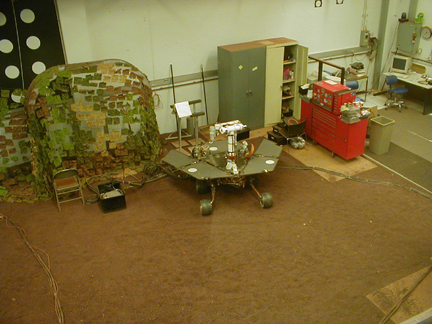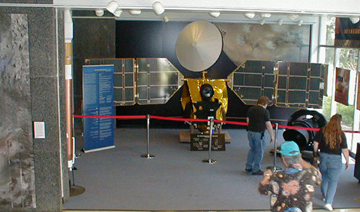Search this Site







OASIS Tours JPL:
From Pasadena to Saturn and Beyond
by Steve Bartlett
Nestled in the foothills north of Pasadena, the NASA Jet Propulsion Laboratory (JPL) is the nerve center of this country's robotic exploration of the cosmos. Local National Space Society chapter members received a rare glimpse inside the workings of the Lab during an OASIS member exclusive private tour on April 10.
JPL employee and former OASIS President Bob Gounley led space enthusiasts through the campus of the renowned site, providing a running commentary on the history and current projects. The tour included the Von Kármán Auditorium, location of many JPL press conferences; the Lab's museum; the Spacecraft Assembly Facility; Mission Control; the rover exercise area.
 |
| A glimpse into the Rover Exercise Room. |
The afternoon group first stopped at Von Karman and saw a short video on the JPL story. A full-size mockup of the Voyager spacecraft dominates one side of the auditorium. There were still vestiges from recent press conferences for the Mars Exploration Rover (MER) project, including a simulated Marscape and panoramic views of the Opportunity rover landing site.The Stardust spacecraft, which collected samples from a passing comet and is bringing those samples back to Earth, was also prominently displayed.
The Lab's museum, next to the auditorium, recently served as the media command post for the MER mission. As a result, some of the displays normally housed there were in temporary storage. OASIS members still enjoyed seeing the full-size models of the Galileo spacecraft and the Mars Pathfinder rover, as well as subscale models of every robotic probe built at the facility beginning with the Explorer 1 satellite. Gounley, who worked on Galileo for several years, related stories about the heroic efforts to salvage the mission.
The next stop was the construction area for all JPL's robotic explorers-the Spacecraft Assembly Facility. The Facility's high bay area accommodates everything from the largest to the smallest spacecraft. Final assembly of the Cloudsat spacecraft was underway during the tour. Visitors also saw full scale models of the nuclear reactors planned for the Jupiter Icy Moons Orbiter.
 |
| OASIS members examine the Mars Reconnaisance Orbiter display. |
To prepare unmanned rovers for the surfaces of other planets, mission developers use the rover exercise room, a rock and dirt strewn "sandbox". Several versions of MER rovers, as well as other rovers under development, were scattered about the building's floor. With light levels and coloration adjusted to emulate the Martian surface, the facility allows researchers to realistically simulate what a rover might see. A fine patina of brick-red dust covered every surface in the room, requiring Lab technicians to take special provisions to protect sensitive equipment.
Every spacecraft operated by JPL is run from the Mission Control room. There, NASA engineers and scientists direct each day's mission activity, whether scooping up Mars rocks to collecting samples of comets, bouncing radar signals off Venus, or taking photos of the turbulent surface of Jupiter's moon Io. Mission Control is also the operating facility for the Deep Space Network, the radio antenna array spread around the globe that sends and receives messages between Earth and distant space probes.
Fascinating robotics at JPL were not limited to rovers and satellites. Gounley patiently waited at two separate break areas while less jaded tour members clustered around to watch bottles of soda or ice cream bars delivered using high-tech robotic vending machines.
The tour ended at the Mars Reconnaissance Orbiter (MRO) display. The orbiter is the next generation of remote sensing satellites and features a large, high-resolution telescope that will take detailed images of Mars.
OASIS tour participants also received special briefing packages on JPL and its ongoing work. The chapter extends its thanks to Mr. Gounley for volunteering his time and effort to conduct the tours.
Copyright © 1998-2005 Organization for the Advancement of Space Industrialization and Settlement. All Rights Reserved.